[amazon_link asins=’B004X8IR0A,B00E4MRFGW,B004MUEQ6S,B001F0R4SK,B008LRALIA,B004Z8GXWM,B001ET6ZSC,B015RYEBIA,B005IHVRZW’ template=’ProductCarousel’ store=’finmeacur-20′ marketplace=’US’ link_id=’8c6633d9-78d3-11e7-8dcd-ed244ac4df8d’]
Alternative Names : Bloodshot eyes; Red eyes; Scleral injection; Conjunctival injection
Definition :Red eyes are caused by enlarged, dilated blood vessels leading to the appearance of redness on the surface of the eye.
CLICK TO SEE
Considerations
There are many possible causes of a red eye or eyes. Some are cause for concern, some are medical emergencies. Others are of no consequence or concern at all. The degree of redness or appearance of blood usually does not correlate to how serious the situation is. It is generally more important whether you also have eye pain or impaired vision.
Causes
Bloodshot eyes appear red because the vessels in the surface of the white portion of the eye (sclera) become enlarged and irritated. This may result from extremely dry air, sun exposure, dust, foreign body, an allergic reaction, infection, trauma, or other conditions.
One common cause of a red eye is straining or coughing. This can lead to a bright red, uniformly dense bloody area on the sclera. This is called a subconjunctival hemorrhage. Although this bloody area may appear alarming, it is a fairly common occurrence and of little significance. If you notice a bloody blotch in one eye that doesn’t hurt, but just looks bad, don’t worry. It generally clears up on its own within a week or two.
Eye infections or inflammation can occur in different locations. They cause redness as well as possible itching, discharge, pain, or vision problems:
*Blepharitis — inflammation of the eyelash follicles along the eyelid. It is caused by skin bacteria. Itching is common and your eyelids may appear greasy or crusty.
*Conjunctivitis: inflammation or infection of the membrane that lines the eyelids and coats the surface of the eye (the conjunctiva). This condition is often referred to as “pink eye”. It may be caused by a virus, bacteria, allergy, or irritation. If caused by an organism, this is highly contagious.
*Corneal ulcers –– often caused by a bacterial or viral infection. (The cornea is the outer covering of the eye.)
Uveitis –– inflammation of the uvea, which includes the iris, ciliary body, and choroid. This is often related to an autoimmune disorder, infection, or exposure to toxins. Often, only the iris is inflamed, which is called iritis.
Other potential causes include:
*Cold or allergies.
*Foreign objects in the eye that cut or damage the eye. (See eye emergencies.)
*Acute glaucoma : –– a sudden increase in eye pressure that is extremely painful and causes serious visual disturbances. This is a medical emergency. Most times, glaucoma is chronic and gradual.
*Corneal scratches caused by sand, dust, or overuse of contacts.
*Bleeding problems (for example, from excess use of blood thinning drugs).
Home Care
For fatigue or eyestrain, try to rest your eyes. No treatment is necessary.
If you have conjunctivitis:
*Avoid touching the infected eye and then rubbing the other eye — the infection can spread from one eye to the other.
*Apply cool or warm compresses throughout the day.
Over-the-counter homeopathic eye drops may provide relief.
*Do not use eye makeup or wear contact lenses until the infection has cleared. Throw away items like these that you used in your infected eye.
*Wash your hands frequently.
If you have blepharitis:
*Apply warm compresses to your eyes for 5 minutes. Do this at least 2 times per day.
*Using a cotton swab, gently rub a solution of warm water and no-tears baby shampoo along your eyelid, where the lash meets the lid. Do this in the morning and before you go to bed.
.
When to Contact a Medical Professional
Go to the hospital or call 911 if:
*Your eye is red after a penetrating injury.
*You have a headache along with blurred vision or confusion.
*You are seeing halos around lights.
*You have nausea and vomiting.
.
Call your doctor if:
*Your eyes are red longer than 1-2 days.
*You have eye pain or vision changes.
*You take blood thinning medication, like warfarin.
*You may have an object in your eye.
*You are very sensitive to light.
*You have a yellow or greenish discharge from one or both eyes.
.
What to Expect at Your Office Visit:
Your doctor will take your medical history and perform a physical examination which will include a detailed eye exam.
To help diagnose the cause of the problem, your doctor will ask medical history questions, such as:
*Are both of your eyes affected? If only one eye, which one?
*What part of the eye is affected — the white part, or elsewhere?
*Did the redness come on suddenly?
*Have you ever had eye redness before?
*Do you have eye pain? Does it get worse after movement of the eyes?
*Do you have other symptoms like eye discharge, burning or itching? Nausea or vomiting? A headache?
The eyes may need irrigation with normal saline solution, and any foreign bodies will need to be removed. Eye drops may be prescribed.
Homeopathic Remedy.…………...(1).…………(2)
Prevention :
To prevent conjunctivitis:
*DO NOT share anything that has touched the eye of someone with this contagious condition — like pillowcases, sheets, towels, or eyeliner.
*Wash your hands right away if you have come in contact with someone with conjunctivitis.
*Wash out any chemicals or objects from your eye immediately.
Disclaimer: This information is not meant to be a substitute for professional medical advise or help. It is always best to consult with a Physician about serious health concerns. This information is in no way intended to diagnose or prescribe remedies.This is purely for educational purpose
.
Resources:
http://www.nlm.nih.gov/medlineplus/ency/article/003031.htm


























